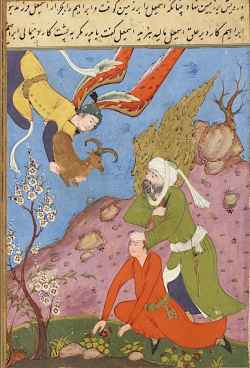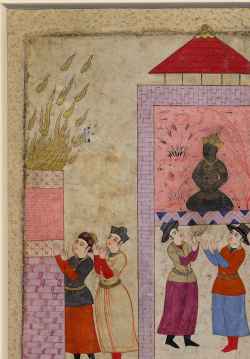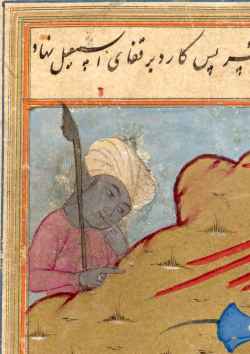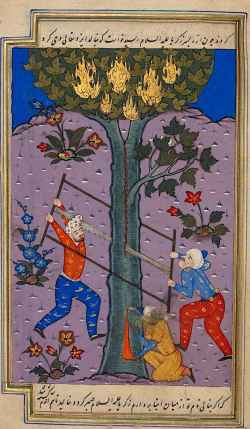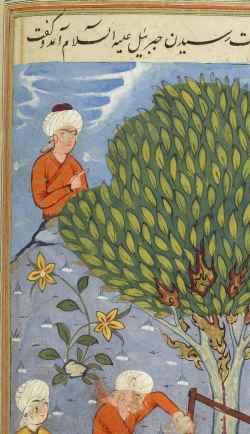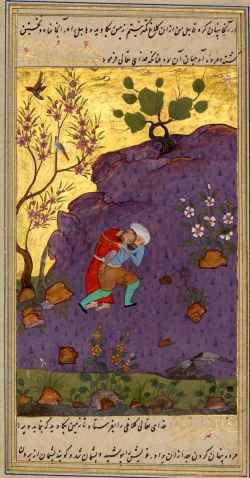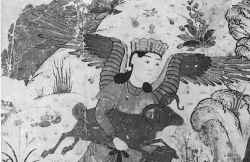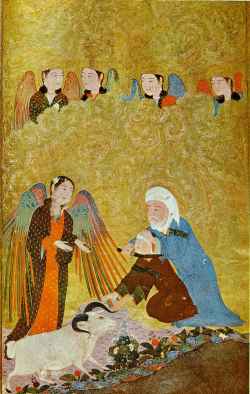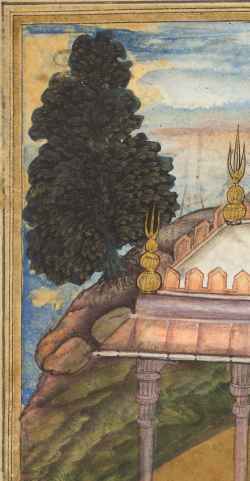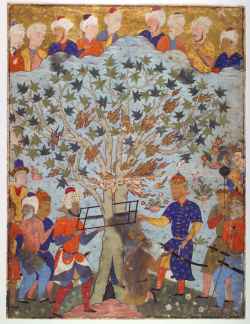Keyword: Persia
Sheep, Wheat, and Wine: An Achaemenian Antecedent of the Sasanian Sacrifices pad ruwān
in: Bulletin of the Asia Institute - Iranian and Zoroastrian Studies in Honor of Prods Oktor Skjærvø , v. 19 (2005), issue : pp.111-118.
Aspects of the ‘Interiorization’ of the Sacrifice in the Zoroastrian Tradition
in: Zoroastrian Rituals in Context, pp. 233-252
Leiden: Brill, 2004.
The rebound theater state: the politics of the Safavid camel sacrifice rituals, 1598-1695 C.E.
in: Iranian Studies, v. 37 (2004), issue 3: pp.451-478.
Abraham's Sacrifice (1595)
from: Histoire du Coran ou Histoire des prophètes et des rois passés. Qisas al-anbiyyâ [Supplément Persan 1313, fol. 40]
Bibliothèque nationale de France, Paris
Ibrâhîm [Abraham] holding a knife is about to sacrifice his son Ismâ'îl (Ishmael) who kneels before him (1580)
from: Qisas al-Anbiyâ [Qazvin?]
The New York Public Library, Spencer Coll. Persian MS. 46
Martyrdom of the prophet Zakarīyā (Zechariah) (XVI)
from: Nīšāpūrī, Isḥāq Ibn-Ibrāhīm: Qiṣaṣ al-anbiyāʾ
Staatsbibliothek zu Berlin, Diez A fol. 3
Martyrdom of Zakariya (XVI)
from: ishâq nishâbûrî, qisas-i qur'ân. [Qazvin, Iran]
Paris, BnF, Persan 54, fol. 144v
Qābil (Cain) and the dead Hābil (Abel) (XVI)
from: Nīšāpūrī, Isḥāq Ibn-Ibrāhīm: Qiṣaṣ al-anbiyāʾ
Staatsbibliothek zu Berlin, Diez A fol. 3
The Martyrdom of Zakarîyâ (Zacharias), the father of John the Baptist, who is killed when the tree in which he is hiding is sawn in two (c. 1580)
from: Nīsābūrī, Abū Isḥāq Ibrāhīm ibn Manṣūr, Qisas al-Anbiyâ [Qazvin?]
The New York Public Library, Spencer Coll. Persian MS. 46, fol. 144
The Sacrifice of Isaac (1430)
from: Ms Hazine 2153, fol. 119
Istanbul, Topkapi Palace Museum, Hazine 2153, fol. 119
The Sacrifice of Isaac (16th)
from: Qiṣaṣ al-anbiyāʾ, Nīšāpūrī, Isḥāq Ibn-Ibrāhīm
Staatsbibliothek zu Berlin, Diez A fol. 3
The Sacrifice of Isaac (Persia, Shiraz, Timurid period) (1410-1411)
from: Miniature from the Anthology of Sultan Iskandar (Persia, Shiraz)
Gulbenkian Museum, Lisbon
Yaja and Upayaja perform a sacrifice for the emergence of Dhrishtadyumna from the fire (1598)
from: from Adi-parva (volume one) of the Razm-nama (Book of Wars) adapted and translated into Persian by Mir Ghiyath al-Din Ali Qazvini, known as Naqib Khan (Persian, d. 1614) from the Sanskrit Mahabharata
The Cleveland Museum of Art
The story of the prophet Zakariya (a conflation of Zacharias, the father of John the Baptist, and the Old Testament prophet Zachariah), who according to Muslim legend died a martyr's death. Escaping his pursuers by hiding in a tree that miraculously opened to admit him, Zakariya was betrayed by Iblis, the devil, who pointed out the hem of the prophet's cloak protruding from the trunk. The devil's forces sawed the tree apart and with it Zakariya, whose saintly aura is shown as flames bursting among the leaves. (1550-1560)
from: from a dispersed copy of the Falnama (Book of Omens)
Worcester Art Museum

